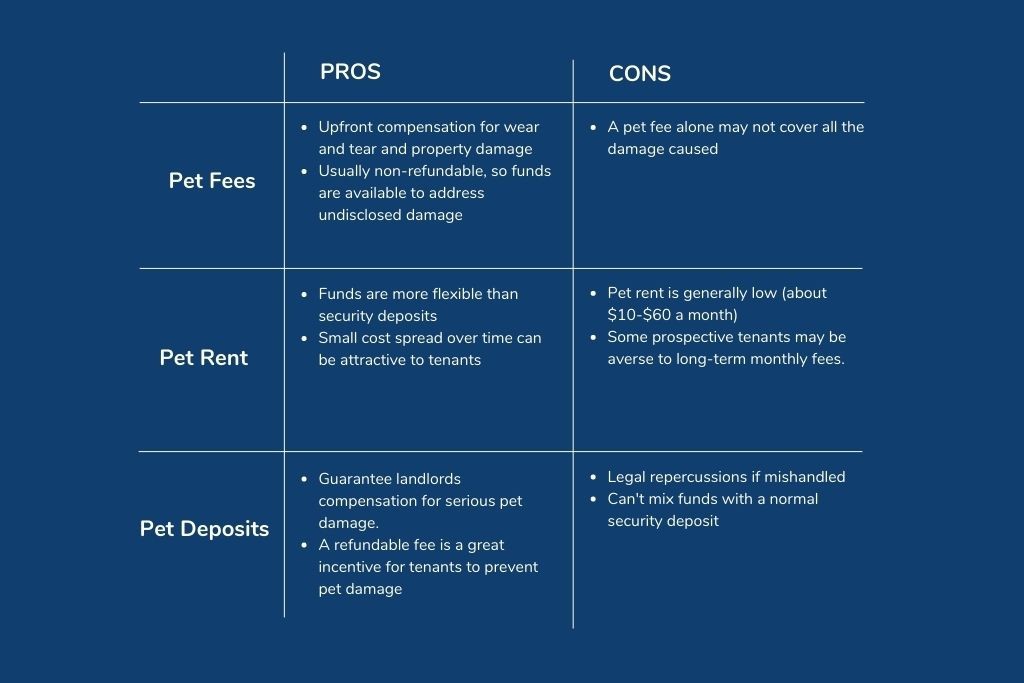For pet lovers, the idea of renting with their furry, scaled, or feathered companions is a dream come true. Pet-friendly rentals are increasingly common, reflecting the large number of households with pets. However, for landlords, welcoming pets into their properties brings up important considerations, especially concerning potential damage. This is where pet deposits come into play. But a common question for both landlords and tenants is: is a pet deposit refundable?
Understanding the nuances of pet deposits, pet fees, and pet rent is crucial for a smooth and transparent landlord-tenant relationship. This article dives deep into pet deposits, specifically addressing their refundability, and how they differ from other pet-related charges. Whether you’re a landlord aiming to protect your investment or a tenant wanting to understand your financial obligations and rights, this guide will provide you with the essential information you need.
Decoding Pet Deposits: What Are They?
A pet deposit is a sum of money collected by landlords to cover potential damages caused by pets residing on their rental property. Think of it as a specific type of security deposit, but earmarked exclusively for pet-related damages. These damages can range from minor issues like carpet stains and scratches to more significant problems such as flea infestations or damaged fixtures.
Crucially, pet deposits are designed to address damages beyond normal wear and tear. Just like with a standard security deposit, landlords cannot use a pet deposit to cover issues that would naturally occur over time, regardless of whether a pet lived there or not. Wear and tear includes things like gently worn carpets or faded paint.
Pet deposits are typically a one-time, upfront fee, collected at the start of the tenancy, similar to a security deposit. The amount can vary, but it’s often a fixed sum or sometimes calculated based on factors like the type and size of pet.
So, Is a Pet Deposit Actually Refundable?
The short answer is yes, pet deposits are generally refundable. This is the key characteristic that distinguishes them from pet fees, which are non-refundable. Because a pet deposit functions similarly to a security deposit, it is designed to be returned to the tenant at the end of the tenancy, provided certain conditions are met.
The refundability hinges on whether the tenant’s pet has caused damage to the property beyond normal wear and tear. If the property is returned in good condition, aside from expected wear and tear, the pet deposit (or the unused portion of it) should be refunded to the tenant.
However, it’s important to understand that “refundable” is conditional. If the pet has indeed caused damage, the landlord is entitled to use the pet deposit to cover the reasonable costs of repairs or cleaning. The amount refunded will then be the pet deposit minus these documented expenses.
Conditions That Affect Pet Deposit Refundability
Several factors determine whether you’ll receive a full, partial, or no refund of your pet deposit. For tenants aiming for a full refund and landlords ensuring fair practice, understanding these conditions is vital:
-
Pet Damage vs. Normal Wear and Tear: This is the central point. Landlords can deduct from the pet deposit for pet-specific damage, such as:
- Stains: Urine or feces stains on carpets, rugs, or flooring that require professional cleaning or replacement.
- Odors: Persistent pet odors that necessitate professional deodorization.
- Scratches and Damage: Scratched doors, walls, floors, or damaged window screens due to pets.
- Broken Fixtures: Damage to appliances, blinds, or built-in furniture caused by pets.
- Flea Infestations: Costs associated with professional pest control to eliminate flea infestations resulting from pets.
Normal wear and tear, which cannot be deducted from the pet deposit, includes:
- Slightly worn carpets in high-traffic areas.
- Minor scratches on floors that occur over time with regular use.
- Faded paint.
The distinction can sometimes be subjective, so clear communication and documentation (like move-in/move-out condition reports with photos) are essential.
-
Proper Cleaning and Repairs by Tenant: To maximize the refundable portion, tenants should take proactive steps to mitigate pet damage and ensure the property is thoroughly cleaned upon move-out. This includes:
- Professional carpet cleaning, especially if pets have been on carpets.
- Repairing any minor pet-related damage they are capable of fixing (with landlord approval).
- Thorough general cleaning to remove pet hair and dander.
-
Lease Agreement Terms: The lease agreement is the governing document. It should clearly outline the terms of the pet deposit, including:
- The amount of the pet deposit.
- Conditions under which it can be withheld.
- The process for refunding the deposit.
Both landlords and tenants should carefully review the pet policy section of the lease.
Pet Deposit vs. Pet Fee vs. Pet Rent: Understanding the Differences
It’s easy to get confused by the different pet-related charges landlords may impose. Understanding the key differences is crucial for financial planning and managing expectations:
-
Pet Deposit: As discussed, a one-time, refundable deposit to cover pet damage beyond normal wear and tear.
-
Pet Fee: A one-time, non-refundable fee for allowing pets on the property. This fee is often intended to cover general pet-related wear and tear or the administrative costs of accommodating pets. Because it’s non-refundable, tenants should not expect this money back, regardless of the condition of the property upon move-out.
-
Pet Rent: An ongoing, monthly charge added to the regular rent for having pets. Pet rent is typically charged for the duration the pet resides on the property. It’s designed to compensate landlords for the ongoing wear and tear and potential risks associated with pets. Pet rent is also non-refundable.
Here’s a simple table summarizing the key differences:
| Feature | Pet Deposit | Pet Fee | Pet Rent |
|---|---|---|---|
| Refundable? | Yes, conditionally | No | No |
| Payment Frequency | One-time, upfront | One-time, upfront | Monthly |
| Purpose | Cover pet damage beyond wear & tear | Cover general pet costs | Cover ongoing pet wear & tear |


Landlords may choose to use one, or a combination of these charges. For instance, a landlord might charge a pet deposit and pet rent for added protection. Transparency in the lease agreement is key to avoiding misunderstandings.
Legal Considerations and Pet Deposits: What You Need to Know
The legality and regulations surrounding pet deposits can vary depending on state and local landlord-tenant laws. It’s essential for both landlords and tenants to be aware of their rights and obligations in their specific location.
-
State and Local Laws: Some jurisdictions may have specific rules regarding:
- Maximum allowable pet deposit amounts (sometimes tied to the standard security deposit limits).
- How pet deposits must be held and returned.
- Requirements for documenting pet damage and providing itemized deductions.
Landlords must comply with these laws, and tenants should familiarize themselves with them to ensure their rights are protected.
-
Fair Housing Act and Assistance Animals: A critical legal exception exists under the Fair Housing Act (FHA). Landlords cannot charge any pet fees or pet deposits for service animals or emotional support animals. These animals are not considered “pets” under the FHA but rather necessary accommodations for individuals with disabilities.
Requiring a pet deposit for a service animal or ESA is a violation of federal law. Landlords can, however, charge for actual damage caused by an assistance animal, but this is treated the same as damage caused by the tenant themselves, not as pet-related damage, and would typically be deducted from the standard security deposit, not a “pet deposit” (which shouldn’t have been charged in the first place).
Ensuring Pet Deposit Refundability: Tips for Tenants and Landlords
For Tenants:
- Document the Property Condition Upon Move-In: Take photos and videos of the property’s condition before moving in, paying close attention to areas that might be susceptible to pet damage (carpets, walls, doors). Complete a move-in checklist with the landlord, noting any pre-existing damage.
- Understand Your Lease: Carefully review the pet policy section of your lease agreement to understand the terms of the pet deposit and your responsibilities.
- Proactive Pet Care: Train your pet, provide appropriate scratching posts or chew toys, and take steps to prevent damage.
- Address Damage Promptly: If your pet does cause damage, address it promptly. Sometimes, minor damage can be easily and inexpensively fixed if dealt with quickly. Communicate with your landlord about any incidents.
- Thorough Cleaning Upon Move-Out: Clean the property thoroughly when you move out, paying special attention to pet-related cleaning (carpet cleaning, odor removal).
- Document Move-Out Condition: Take photos and videos of the property after cleaning, demonstrating its condition. Attend the move-out inspection with the landlord, if possible.
- Communicate with Your Landlord: Maintain open communication with your landlord throughout your tenancy, especially regarding any pet-related issues.
For Landlords:
- Clearly Define Pet Policies in the Lease: Ensure your lease agreement clearly outlines your pet policy, including pet deposit terms, pet fees (if applicable), and pet rent (if applicable).
- Conduct Thorough Move-In and Move-Out Inspections: Perform detailed move-in and move-out inspections, documenting the property’s condition with photos and written reports.
- Document Pet Damage: If there is pet damage, thoroughly document it with photos, videos, and detailed descriptions. Obtain quotes for repairs or cleaning.
- Provide Itemized Deductions: When withholding any portion of the pet deposit, provide the tenant with a detailed, itemized list of deductions, along with supporting documentation (receipts, invoices).
- Understand Fair Housing Laws: Be knowledgeable about Fair Housing Act requirements regarding service animals and emotional support animals.
- Communicate Transparently: Maintain open and transparent communication with tenants regarding pet deposits and any potential deductions.
Conclusion: Navigating Pet Deposits for a Positive Rental Experience
Understanding whether a pet deposit is refundable is fundamental to responsible renting with pets. Pet deposits, unlike pet fees and pet rent, are indeed refundable, provided the tenant fulfills their obligations and the pet does not cause excessive damage.
For landlords, pet deposits offer a valuable tool to protect their property investment while welcoming pet-owning tenants. For tenants, understanding the refundable nature of pet deposits incentivizes responsible pet ownership and property care.
Clear communication, comprehensive lease agreements, and adherence to legal guidelines are essential for both landlords and tenants to navigate pet deposits successfully and foster a positive and mutually respectful rental experience for everyone – pets included!